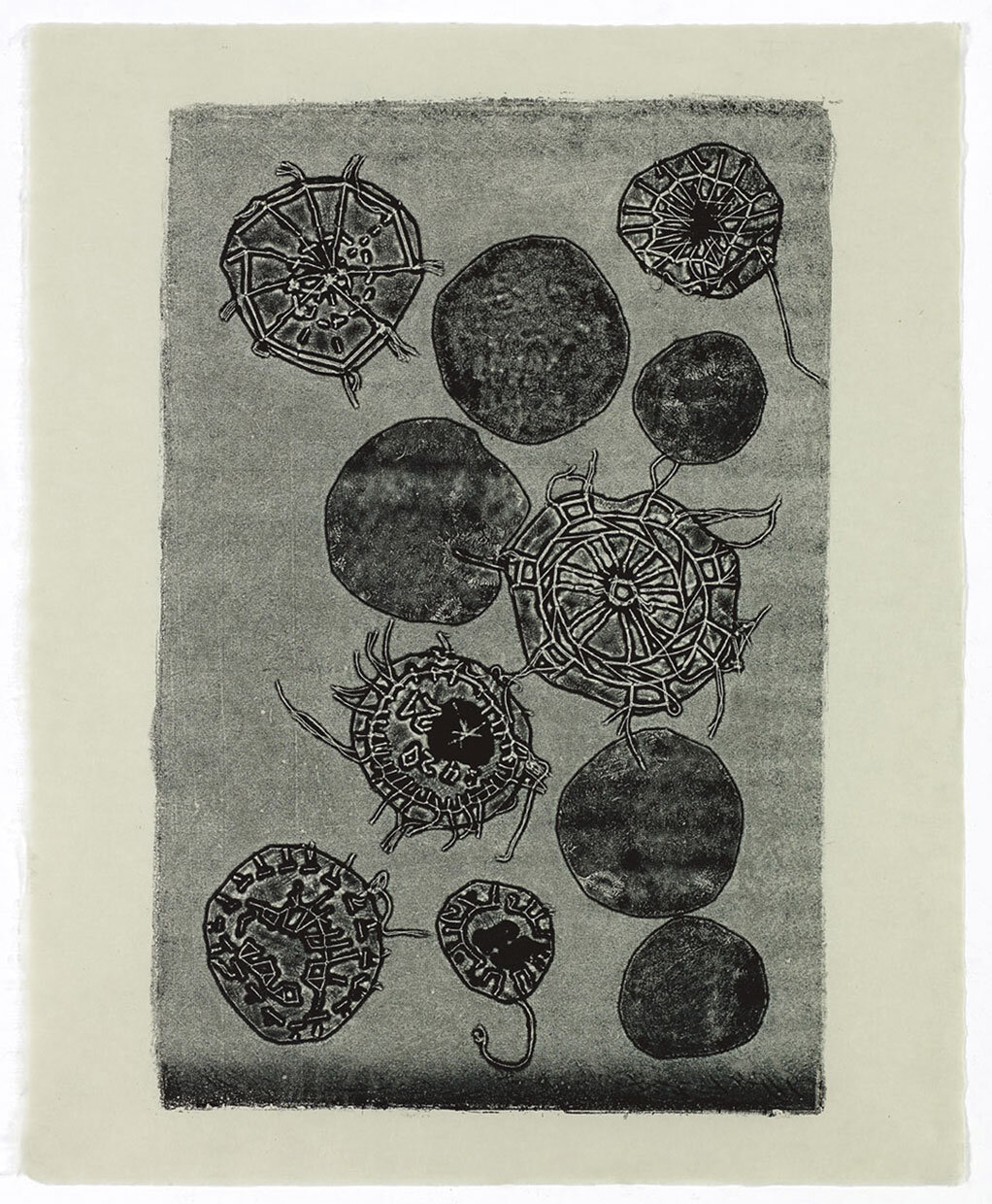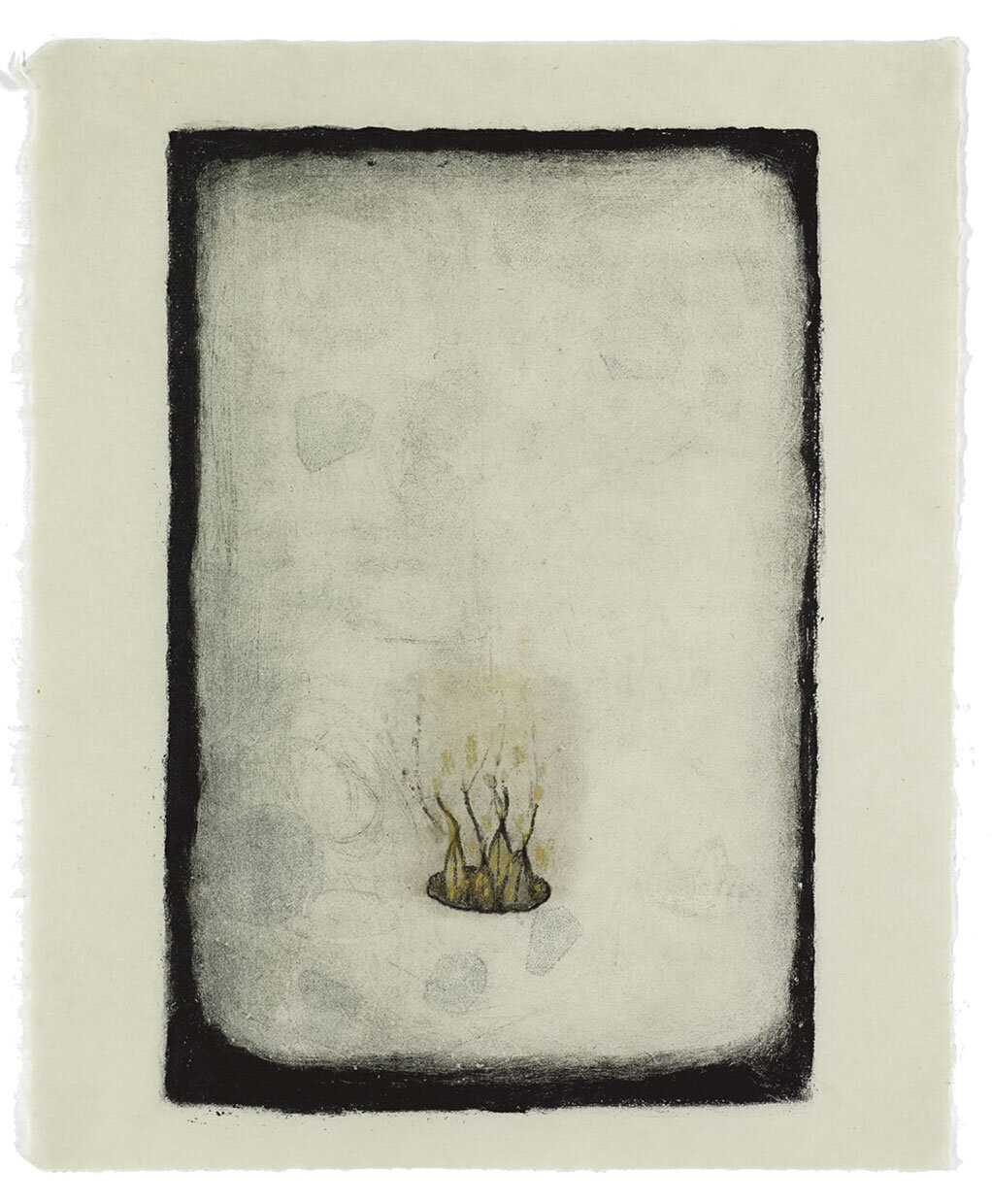Thirty-three consecutive prints, hung at different intervals, make up the spell, like a long sentence that is also a brief journey to the history of space and time. Shiree Rafaeli acts like an alchemist brewing a dark, bitter potion, concerning Time.
An ancient legend tells of a rebellious child and the Nursemaid of the Woods who owns a magic wheel. A turn on the wheel in one direction speeds the teeth of time forward, and the other turns time back. One direction ages us in one fell swoop, and the other takes us back to childhood… Two persistent images emerge repeatedly, establishing themselves as archetypes: the water wheel and the nursemaid's hand. They soon become a set of instructions. One dictates the pace, the other – direction… Rafaeli's wheel allows us to travel in time, to grow old or become young. Rafaeli is both the nursemaid and the punished child. She has control but is also a subject of the wheel's motion.
"O Slowly, Slowly Run, Horses of the Night" – the paradoxical command/plea, appears first in Ovid's Amores, where the protagonist wishes to buy some time with his mistress, then in Marlow's Faustus, where, knowing that his death is near, Faustus seeks one last hour among the living, before Lucifer carries him to Hell. Rafaeli's prints are the night horses' carriage. They gallop within the press, ejected one after the other, threatening to use up all the black ink, but at the same time they provide a deferment. They promise existence and continuity, and refuse to fade away.
Yair Barak, curator
THE SPELL
Untitled, 52cm x 43cm, Embroidery collagraph on Awagami Kitakata Paper, 2020
Untitled, 52cm x 43cm, Embroidery collagraph on Awagami Kitakata Paper, 2020
Untitled, 52cm x 43cm, Embroidery collagraph on Awagami Kitakata Paper, 2020
Untitled, 52cm x 43cm, Embroidery collagraph on Awagami Kitakata Paper, 2020
Untitled, 52cm x 43cm, Monotype on Awagami Kitakata Paper, 2019
Untitled, 52cm x 43cm, Monotype on Awagami Kitakata Paper, 2019
Untitled, 52cm x 43cm, Monotype on Awagami Kitakata Paper, 2020
Untitled, 52cm x 43cm, Monotype on Awagami Kitakata Paper, 2020
Untitled, 52cm x 43cm, Collagraph, drypoint and trace monotype on Awagami Kitakata Paper, 2019
Untitled, 52cm x 43cm, Collagraph, drypoint and trace monotype on Awagami Kitakata Paper, 2019
Untitled, 52cm x 43cm, Embroidery collagraph, trace monotype on Awagami Kitakata Paper, 2020
Untitled, 52cm x 43cm, Collagraph, drypoint and trace monotype on Awagami Kitakata Paper, 2020
Untitled, 52cm x 43cm, Collagraph on Awagami Kitakata Paper, 2020
Untitled, 52cm x 43cm, Collagraph on Awagami Kitakata Paper, 2020
Untitled, 52cm x 43cm, Collagraph and trace monotype on Awagami Kitakata Paper, 2020
Untitled, 52cm x 43cm, Collagraph, drypoint and trace monotype on Awagami Kitakata Paper, 2020
Untitled, 52cm x 43cm, Collagraph and trace monotype on Awagami Kitakata Paper, 2020
Untitled, 52cm x 43cm, Collagraph, drypoint and trace monotype on Awagami Kitakata Paper, 2020
Untitled, 52cm x 43cm, Collagraph, drypoint and trace monotype on Awagami Kitakata Paper, 2020
Untitled, 52cm x 43cm, Collagraph on Awagami Kitakata Paper, 2020
Untitled, 52cm x 43cm, Collagraph and drypoint on Awagami Kitakata Paper, 2020
Untitled, 52cm x 43cm, embroidery collagraph and drypoint on Awagami Kitakata Paper, 2020
Untitled, 52cm x 43cm, drypoint and monotype on Awagami Kitakata Paper, 2020
Untitled, 52cm x 43cm, drypoint and monotype on Awagami Kitakata Paper, 2020
Untitled, 52cm x 43cm, Collagraph on Awagami Kitakata Paper, 2020
Untitled, 52cm x 43cm, Collagraph and monotype on Awagami Kitakata Paper, 2020
Untitled, 52cm x 43cm, Collagraph and drypoint on Awagami Kitakata Paper, 2020
Untitled, 52cm x 43cm, Wax pencil transfer and monotype on Awagami Kitakata Paper, 2020
Untitled, 52cm x 43cm, Wax pencil transfer and monotype on Awagami Kitakata Paper, 2020
Untitled, 52cm x 43cm, Wax pencil transfer and monotype on Awagami Kitakata Paper, 2020
Untitled, 52cm x 43cm, Wax pencil transfer and monotype on Awagami Kitakata Paper, 2020






























